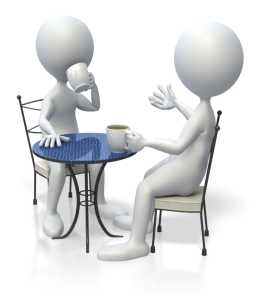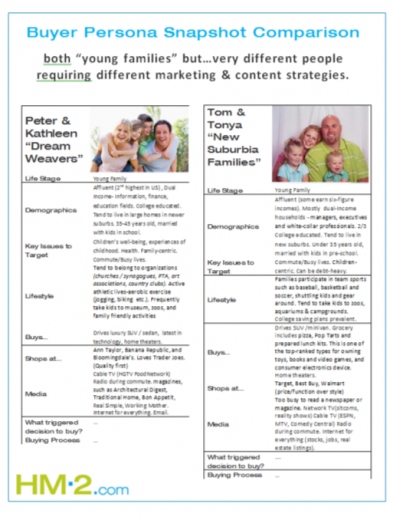If you know your customer, you can do great things. If you don’t -well... Buyer Personas are the foundation for effective marketing & they make everything so much easier. Consider…the other day a homebuilder friend mentioned how his weekly marketing meeting always included brainstorming ideas for upcoming blog or Facebook posts along with murmurs of “what about Pinterest…”
The Good: they realize the need for content to participate in social media channels. The Slightly Disturbing: the apparent lack of focus and plan to make content meaningful and effectively distributed for buyers. (sigh)
KEY POINT: To create marketing strategy & content that works, you need to begin by returning to the center of what marketing and business is about –The Customer.
“who is our buyer?”
In the home building industry where I spend a lot of time, you hear a lot about the ‘young professional couple‘, ‘young family with kids‘,’ mature family‘ and the ‘empty-nesters‘. Now we also hear about ‘multi-gen‘ where aging parents move-in or 20 to 30 somethings move-back (or never leave-yikes!).
But what do these few words really tell place designers, marketers and other ‘meaning-makers’ in creating product and content that is really valued by customers? These ‘customer descriptors’ are so generic that they are slipped into hundreds of marketing plans for communities across the country and few ever notice that the customer targets never change.
This stereotype approach to buyers is true of too many companies across categories.
THE RESULT: Generic and shallow communications that are meaningful to no one.
what is a buyer persona?
“Buyer Persona: (n) a composite sketch of the real people who buy, or might buy, products like the ones you sell. It should go beyond traditional demographics and delve into behaviors, motivations, likes/dislikes, etc..”
A good buyer persona conveys enough information that designers and writers can create products and content with empathy for the intended buyer – not in terms of being a set of statistics, but as a real-life person. It’s about his or her worldview, not you or your product.
why use buyer personas?
 Marketing changed when social media channels (blogs, forums, review sites, Facebook, Twitter etc.) entered the picture and marketing moved to 2-way conversation, rather than broadcasting of messages (more on that here). Now brands are expected to talk with people and be human in what they say & how they say it.
Marketing changed when social media channels (blogs, forums, review sites, Facebook, Twitter etc.) entered the picture and marketing moved to 2-way conversation, rather than broadcasting of messages (more on that here). Now brands are expected to talk with people and be human in what they say & how they say it.
Buyer personas help brands be more personal and authentically address specific needs of specific types of people. They shift marketing efforts away from broadcasting product and company-centric messages and towards providing useful, customer-centric content that a person would actually find valuable.
KEY POINTS: 1) It’s not about the product, it’s about the customer and the relationship. THEN – it’s about the sale and/or the referral. 2) Buyer Personas help you create engagingly relevant content and to know where to promote it.
how to create a buyer persona
STEP 1: Identify Your Most Common Buyers and Potential Buyers
First, take stock of what buyer insights you have and what you are missing. Begin by identifying your key customer segments. Review your current buyer, shopper and other market information. Typically buyer trends in life stage, demographics, motivations and behavior will emerge.
Next, give a descriptive name to each group of key targeted buyers and briefly note life stage, demographics, geography, motivations and other behaviors observed in online forums; through social media; anywhere. Include insights and feedback from sales and customer service in this initial exercise. [NOTE: For real estate developers and homebuilders, geo-demographic reports such as Nielsen’s PRIZM or Experian’s Mosaic can be quite helpful here.]
HINT: Keep in mind that you will need to generate meaningful content and experiences for each buyer persona. Given your marketing capacity, try to realistically narrow your number of buyer personas as much as possible by focusing on the most important customer segments to your business.
STEP 2: Get Up-Close & Personal With Buyers
 Now your research becomes more qualitative. Interview customers (preferably who bought within the last 30 to 60 days), prospective customers and if possible prospects that purchased from your competition. The goal is to vet and refine the initial assumptions of Step One and bring greater dimension and insight to each profile.
Now your research becomes more qualitative. Interview customers (preferably who bought within the last 30 to 60 days), prospective customers and if possible prospects that purchased from your competition. The goal is to vet and refine the initial assumptions of Step One and bring greater dimension and insight to each profile.
Interviews. For each buyer persona conduct at least five 30-minutes interviews and more if you can as the larger your sample set, the more credence your data will have. At minimum ask to record the interview and if possible film it. The nuance and emotion of how people answer is very telling.
SOME SAMPLE QUESTIONS FOR BUYER INTERVIEW GUIDE:
The Buyer’s World Beyond What Your Company Does. Basically, the goal here is to discover what their life is about right now. Tell me about a day in your life. What is it like during the week? What about weekends? What is important to you? What would you say are the main challenges you are dealing with at this point? What do find motivating? What trends are influencing them? What are your top 3 favorite things to do?
How The Buyers Life Relates to the Product You Provide. What does [home] mean to you? Here we want a couple of very open-ended questions about the category and/or product you provide. Let them take it wherever they want. THEN – you can add in other product questions if you like.
The Buying Process. What happened on the day you decided to look for a [home or other product ] this? What process did you go through to find potential homes? How did you narrow the options down? What criteria did you use to evaluate the options? How did we fare against the competition by those criteria? What influenced you in purchasing? [NOTE: if you haven’t read “How people really shop”…you should.]
HINT: In this section, we are looking to understand how they shop and where they get their information as it directs where we promote. So, if needed be prepared to ask clarifying questions regarding media, including if they read blogs, forums or are active on Facebook, Twitter, Pinterest or other social networks.
What haven’t I asked you that I should? Probably the best question of them all.
STEP 3: Create Your Buyer Personas.
Analyze the information gathered and craft your buyer personas to be easy to understand and useful. In sharing the personas with designers and marketing teams, consider incorporating buyer video and/or audio from your interviews for greater insight.
FINAL THOUGHT: Everything about your marketing efforts should be tied to personas. They are foundational to brand communication and experience design. Marketing today is personal and about the customer. Brands need to be able to see the world through their buyers’ eyes to be effective and Buyer Personas are the first step.
Thanks for stopping by & to get greater insight into your buyers -Let’s talk. Also, I’d love to hear your perspectives Weigh in below or catch me on Twitter at @HollyHM2 . Until next time – Cheers!






